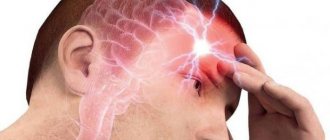The concept of vegetative-vascular dystonia (VSD) includes a whole range of symptoms. The patient’s complaints are not specific; it is difficult to say in which system the violation occurred and which disease causes certain manifestations. If we evaluate the symptoms comprehensively, then they are not characteristic of any other pathology.
Most modern doctors agree that VSD does not exist - it is a pseudo-diagnosis that requires a more careful and thorough examination of the patient. It is important to establish and eliminate the underlying disease, then the symptoms of vegetative-vascular dystonia will gradually disappear.
What is the autonomic nervous system (ANS)
The autonomic or autonomic nervous system (NS) in the human body is responsible for the functioning of the endocrine glands, organs, lymphatic and circulatory systems. Stable operation of the ANS is constant homeostasis, a person’s ability to adapt to environmental changes.
The autonomic nervous system consists of two sections with opposing functions:
- Sympathetic NS. The department is responsible for increasing the strength and intensity of heart contractions, for narrowing blood vessels, for inhibiting gastrointestinal motility, for inhibiting the digestive and salivary glands, for increasing ventilation of the lungs, and for relaxing the sphincters of the bladder.
- Parasympathetic NS. Excitation in this part of the nervous system leads to bradycardia, excessive release of enzymes in the gastrointestinal tract, spontaneous compression of the bladder sphincter, shortness of breath, constriction of the pupils, and increased salivation. Parasympathetic nervous system has virtually no effect on the condition of blood vessels, with the exception of dilatation of the coronary, pulmonary arteries, arteries of the brain and genital organs.
In a healthy person, both parts of the nervous system balance each other. The body adequately adapts to changes in its own condition and in the environment. When there is a violation of the coordination between the sympathetic and parasympathetic departments, vegetative-vascular dystonia develops.
Vegetative-vascular dystonia ( VSD
) is a complex of various clinical symptoms, which “in general” is characterized by disturbances in the functioning of the human autonomic nervous system. The autonomic nervous system is responsible for the coordinated functioning of internal organs, exocrine and endocrine glands, blood and lymphatic vessels, and is responsible for such important body functions as: breathing, circulation, digestion, metabolism, excretion, reproduction and growth functions.
Vegetative-vascular dystonia has several synonyms: autonomic dysfunction, autonomic dystonia, neurocirculatory dystonia (NCD).
Vegetative-vascular dystonia is not an independent disease, but a set of clinical symptoms that are the result of disturbances in the functioning of certain systems or organs of the human body. Or a set of clinical symptoms that go hand in hand with certain diseases or syndromes. For example, such as: cardiac neurosis, angioneurosis, panic attack, functional cardiopathy, vasomotor dystonia, psychovegetative syndrome, neurotic disorders and others.
Since everything in the human body is interconnected, disturbances in the functioning of a particular organ or system affect the functioning of other organs and systems. For example, disturbances in the functioning of the cardiovascular system of the human body lead to a failure of the mechanism for the full supply of oxygen to the organs and tissues of the body, as well as a failure of the mechanism for the timely removal of carbon dioxide, waste substances and toxins from the organs and tissues, which, in turn, causes various malfunctions and disturbances in the functioning of the whole organism “as a whole”.
AUTONOMIC NERVOUS SYSTEM
For a more complete understanding of what vegetative-vascular dystonia is, it is necessary to consider the principles of operation of the autonomic nervous system.
The autonomic nervous system (or visceral nervous system) is the autonomous part of the nervous system, i.e. a person cannot consciously influence its work. For example, a person cannot, of his own free will and desire, control and change the functioning of internal organs, external and internal secretion glands (heart, liver, kidneys, spleen, etc.).
The autonomic nervous system regulates and controls the coordinated work of all internal organs, the work of lymphatic and blood vessels, the glands of external and internal secretions, and also performs the function of maintaining balance in the internal environment of the body and its activities.
The “unconscious” control of the autonomic nervous system is responsible for more than 80% of vital functions in the human body. Many processes occur in the body without our direct participation, for example, breathing and heartbeat, digestion, the functioning of the immune system and others. After all, we cannot make our heart beat less often or faster, we don’t think about the fact that we need to breathe, all these processes are controlled by the unconscious part of our brain.
That is, in other words: the activity of the autonomic nervous system is not subject to the control of human consciousness and human will.
The autonomic nervous system regulates many physiological processes and biochemical processes occurring in the body: maintains normal levels of blood pressure, body temperature, is responsible for metabolic processes, urination, digestion, controls heart rate, respiration, controls the activity of the cardiac and vascular systems, immune and endocrine systems, sweating. It also mobilizes the body’s systems to adapt to changing environmental conditions.
The autonomic nervous system is usually divided into its constituent parts: metasympathetic, sympathetic and parasympathetic parts.
The metasympathetic nervous system is responsible for the functioning of internal organs that have contractility (heart, stomach and digestive tract, bladder, etc.).
The sympathetic nervous system is more responsible for daytime wakefulness, mental activity, stress, and physical activity. On the contrary, the parasympathetic nervous system is more responsible for resting the body, restoring strength, and sleeping. These two systems seem to alternate with each other, and this allows the body to expend strength during the day and fully recover at night. For the body to function properly, there must be a balance between these two systems. An imbalance or equilibrium between the sympathetic and parasympathetic systems leads to the occurrence of vegetative-vascular dystonia.
SYMPTOMS OF VEGETIC-VASCULAR DYSTONIA
Vegetative-vascular dystonia can have a variety of symptoms, which are expressed in disruptions in the functioning of various body systems:
- cardiovascular system
: fluctuations in venous and blood pressure from hypertension (high blood pressure) to hypotension (low blood pressure), impaired blood circulation in tissues; pain in the left side of the chest, pain in the heart area, abnormal heart rate, tachycardia (rapid heartbeat), sensation of heart stopping. - respiratory system
: rapid breathing, shortness of breath, feeling of lack of air, difficulty or conversely rapid breathing, inability to take a deep breath or unexpected deep breaths. - gastrointestinal system
: abdominal pain, nausea, vomiting, constipation, belching, heartburn, diarrhea (diarrhea), flatulence. - genitourinary system
: painful and frequent urination, pain and itching in the genital area; sexual disorders and dysfunctions are possible, among the many manifestations of which may be: lack of sexual desire or erection, lack of orgasm with normal sexual desire, and others. - thermoregulatory system
: causeless fluctuations in body temperature, increased sweating, chills, cold or heat waves. - vestibular system
: dizziness, unsteadiness, lightheadedness, tremors in the legs and others. - mental and neurological manifestations, often combined with emotional disorders
: decreased performance, increased fatigue, internal tension, weakness, lethargy, heightened sensitivity to weather changes (meteosensitivity), dizziness, headaches, sleep disturbances and shuddering during sleep, decreased appetite, irritability , sudden mood swings, tearfulness, causeless feelings of anxiety and restlessness, various fears.
CAUSES OF VEGETIC-VASCULAR DYSTONIA
Psychological aspect
The occurrence of vegetative-vascular dystonia, according to statistics, is one of the most common and significant for consideration, because each person has unique characteristics and psychological characteristics, and because of this, stress, chronic fatigue, overwork, overwork, and neuroses are a common cause of the disease. Very often, people who experience constant stress experience overstrain (overload) of the body. This leads to exhaustion of the body, as well as to a decrease in the adaptive and protective capabilities of the body. First of all, this affects regulatory systems and leads to disruption of the regulation and proper functioning of blood vessels and internal organs.
Also, an equally significant aspect of the occurrence of vegetative-vascular dystonia is diseases of the spine
or various problems with it (for example, displacement of the vertebrae). Thus, quite often one has to deal with the fact that disturbances in the functioning of internal organs, pain in them, impaired sensitivity of the limbs, headaches, weather sensitivity and other manifestations are the result of a certain disease of the spine, which results in pinching (compression) of the spinal nerve root (or several roots at the same time). The consequence of such infringement of the nerve root is a violation of innervation (control of the functioning of tissues and organs with the help of nerves), pain, disruption of the functioning of the organ that is controlled through the affected nerve.
Factors under the influence of which vegetative-vascular dystonia develops:
- excessive physical, emotional and mental stress, irregular sleep, overwork;
- stress, emotional stress, neurosis and other neurotic disorders;
- diseases of the spine (osteochondrosis, often cervical osteochondrosis, radiculitis and others), as well as various problems with the spine;
- hereditary predisposition, congenital disorders of the nervous system, physical inactivity acquired in childhood;
- hormonal changes in the body during periods: puberty, menopause, pregnancy, after taking contraceptive and hormonal drugs;
- climate change;
- previous intoxications and various infectious diseases, decreased immunity;
- exacerbation of endocrine diseases (thyroid gland, gonads, adrenal glands, thyrotoxicosis, diabetes mellitus);
- brain damage (various injuries, strokes, tumors);
- smoking in large quantities;
- frequent consumption of alcoholic beverages.
TYPES OF VEGETIC-VASCULAR DYSTONIA
It is customary to distinguish three types of vegetative-vascular dystonia. The classification depends on the level of blood pressure and a number of clinical symptoms:
- hypertensive type
(characterized by high blood pressure). - hypotonic type
(characterized by low blood pressure). - mixed type
(characterized by periodic fluctuations in blood pressure).
All types of vegetative-vascular dystonia are characterized by vegetative-vascular crises
, significantly worsening a person’s performance and general well-being.
For hypertensive type
There is increased blood pressure, rapid heartbeat, sudden agitation, chills, cold extremities, and symptoms of a panic attack.
With hypotonic type
low blood pressure, cardiac arrest, shortness of breath, sweating, nausea, and general weakness are observed.
For mixed type
The possibility of spontaneous manifestation of both of the above symptoms is characteristic; they can be combined or present simultaneously.
The formation of crises is based on an excessive concentration of biologically active substances in the body, such as acetylcholine, norepinephrine, adrenaline, etc., as well as the heightened sensitivity of the receptors of the endocrine and nervous systems to these substances. A crisis can be provoked and activated by disturbances in rhythm and lifestyle, changes in climatic zones and climate change, intoxication, physical and emotional overload.
RISK GROUPS FOR VEGETIC-VASCULAR DYSTONIA
Vegetative-vascular dystonia is one of the most common diseases and is diagnosed in approximately 80% of the population aged 45 - 50 years. Men and women are equally susceptible to the disease. It is worth noting that there is a hereditary predisposition to this disease.
The first manifestations of vegetative-vascular dystonia can be observed already in childhood or adolescence. The disease that occurs at this age becomes an unfavorable background for the development of a number of other diseases. The main symptoms are: feeling of weakness, headache, absent-mindedness, intracranial pressure, constant fatigue, elevated body temperature, lack of appetite, moodiness. Many parents begin to completely protect their child from sports, swimming, and prolonged exposure to the air. All this can lead to even greater weakening of the child in the future.
More pronounced disorders often appear between the ages of 20 and 30 and are characterized by headaches, ringing and tinnitus, dizziness, tachycardia, irritability, insomnia and other manifestations.
In adulthood, vegetative-vascular dystonia is often accompanied by many other diseases, such as spinal diseases, endocrine diseases, mental disorders, often chronic.
PREVENTION OF VEGETIC-VASCULAR DYSTONIA
A number of the aspects listed below will significantly help in preventing the disease, normalizing the body’s activity and restoring psychological balance.
- Full sleep.
Harmonization of work and rest. The duration of sleep should be at least 8 - 9 hours a day. It is better not to exhaust your body with chronic lack of sleep, as this can affect the nervous system, aggravate existing disorders and provoke the occurrence of many ailments. Alternate physical, mental and emotional stress with proper rest and relaxation psychological relief (yoga classes, auto-training, walks in nature, relaxing massage). It is necessary to take short breaks during the day while working, especially if it is working on a computer or physically difficult work. Sanatorium-resort treatment is quite effective. - Healthy eating.
You should avoid overeating, especially at night. You should eat often, but in small portions, eat a variety of foods (fish, meat, dairy products, vegetables, fruits). The most useful and best absorbed by the body are products from the geographical area in which you live and where your ancestors lived (for example, for residents of Ukraine, apples are much healthier than exotic mangoes or pineapples). - Rejection of bad habits.
It is necessary to give up or limit yourself as much as possible from bad habits (smoking, alcohol and others). - Physical activity.
An active lifestyle, as well as walks in the fresh air, have a beneficial effect on all aspects of the human body, in particular for its psychological and emotional balance. Daily exercise, gymnastics, physical education, swimming, fitness, walks in the fresh air and more positive emotions are beneficial.
TREATMENT OF VEGETIC-VASCULAR DYSTONIA
The treatment tactics for vegetative-vascular dystonia are complex treatment using non-surgical methods.
Treatment of vegetative-vascular dystonia is aimed at achieving the following objectives:
- eliminate the cause of the disease;
- stop further development of the disease;
- eliminate the existing consequences of the disease.
The timing of treatment and its results directly depend on the stage of development of the disease, and therefore it is extremely important to diagnose the disease as early as possible.
With timely treatment, the patient’s life changes qualitatively: pain symptoms of the disease disappear (or are significantly weakened), the functioning of vital systems and organs is normalized, the body’s adaptive functions are restored, energy tone is restored, appetite and sleep are normalized, sudden mood swings stop, etc. .
Our medical center has been treating vegetative-vascular dystonia since 2003.
An individual treatment program (course) is developed for each patient based on the type of dystonia, stage of the disease, gender, age, temperament of the patient and other factors.
Treatment course for vegetative-vascular dystonia
in our center consists of 10 - 15 complex treatment sessions. Frequency of visits: daily or every other day. The duration of each complex treatment session is about 1 hour.
Treatment sessions include manual therapy (according to indications), relaxation massage, therapeutic massage, magnetic laser therapy, electromyostimulation, drug therapy and others.
The desire and attitude of the patient play a significant role in achieving positive treatment results in a short time!
Types of VSD
There is no generally accepted classification of the disease. Depending on the prevalence of the symptom complex, three forms of vegetative-vascular dystonia are distinguished:
- Local. The complaints are isolated, the violations are mild.
- Systemic. The disorder affects only one organ system.
- Generalized. The patient has many different complaints, dysfunction of several systems and organs is observed.
According to the severity of symptoms, VSD can be mild, moderate and severe.
According to the nature of the course, permanent (constant), latent (hidden) and paroxysmal (paroxysmal) vegetative-vascular dystonia are distinguished.
Due to the development of the disorder, the pathology is primary, caused by the anatomy and physique of the patient, and secondary, caused by the disease.
Based on the level of blood pressure, VSD is divided into hypotonic, hypertonic and mixed types.
Symptoms of the disease
Several years ago, doctors diagnosed a patient with VSD if they did not find any significant pathology and could not determine a more accurate diagnosis. Now medicine knows that dozens of diseases can be hidden behind vegetative-vascular dystonia. The list of possible symptoms is very wide.
Most often, patients complain of the following types of disorders:
- From the cardiovascular system: heart rhythm disturbances, a feeling of tightness or pain in the chest, increased or decreased blood pressure, sweating, cold palms. Patients report sudden flashes of heat or cold, conditions close to fainting.
- From the respiratory system: feeling of lack of air, lump in the throat. A person cannot breathe deeply.
- From the nervous system: headaches, insomnia, involuntary twitching of the arms and legs, dizziness in a stuffy room. If a person sits or lies for a long time, then if he stands up suddenly, his vision may become dark.
- From the gastrointestinal tract: nausea, loss of appetite, constipation or diarrhea, abdominal pain for no apparent reason. Particularly impressionable patients may develop vomiting and anorexia due to panic.
- From the genitourinary system: erectile dysfunction, urinary disorders. In men, vegetative-vascular dystonia may be accompanied by prostate enlargement. In this case, the infectious agent is not detected. In women, problems in the autonomic nervous system provoke disruption of the menstrual cycle.
- From the emotional state: almost every patient with VSD has mental disorders. A person is constantly tense, excited, not restrained, or, conversely, becomes lethargic and apathetic. Chronic lack of sleep can create fears, cause panic attacks, and weaken memory and attention. Adult men and women often arrive at the doctor's office already feeling very emotionally exhausted. In most cases, psychological instability is not a sign of illness and can be easily corrected by working with specialists.
Despite the fact that there is no diagnosis of VSD in the ICD, the complex of disorders itself is quite common. According to medical statistics, about 80% of the world's population have at least once experienced symptoms of vegetative-vascular dystonia. The disorder occurs not only in adults, but also in adolescents and young people aged 20-30 years.
Symptoms of hypotonic VSD
The clinical picture of VSD is extremely diverse. It often includes dozens of complaints in one patient. It is extremely rare when there are few manifestations and they are stable.
The existing symptoms are nonspecific. They can resemble signs of various diseases, which makes diagnosis especially difficult.
The main symptoms of hypotonic vegetative-vascular dystonia are general weakness and a significant decrease in blood pressure (about 90/60). In addition, the patient may have the following symptoms:
- Paleness of the skin.
- Constantly cold hands and feet.
- Decreased appetite.
- Headaches, pounding in the temples.
- Dizziness.
- Floaters in the eyes, blurred vision, especially with a sudden change in body position.
- Frequent urination.
- Increased sweating.
- Dyspeptic disorders (nausea, belching, pain, intestinal spasms, stool disorders).
- Decreased concentration and memory.
- Pain in the heart area.
- rapid or, conversely, slow heartbeat.
- Shortness of breath, lack of air.
- Sleep disorders.
- Sexual dysfunction.
- Pain in joints, muscles.
- Trembling in the body, goosebumps on the skin.
- Increased fatigue.
- Irritability, tearfulness, emotional lability.
- Panic attacks.
If your body lacks this, you will have panic attacks!
Symptoms can be multiple, isolated, or abruptly replace each other. VSD with low pressure tends to subside for a while and will worsen again. Cases of sluggish, background dystonia are also common.
Diagnosis of vegetative-vascular dystonia
Depending on the prevalence of certain symptoms, it is necessary to undergo examination by a cardiologist, neurologist, therapist or endocrinologist. Often consultations with several specialists are required. Diagnostics is carried out comprehensively.
The patient may be prescribed:
- Electrocardiogram (ECG) to exclude heart pathologies.
- An electroencephalogram (EEG) to evaluate the functioning of different areas of the brain.
- Magnetic resonance imaging (MRI) of a specific area or part of the body to study in detail the internal tissues and structures.
- Ultrasound examination (ultrasound) of organs and blood vessels.
- General and biochemical blood and urine tests.
Based on the examination results, the doctor determines further tactics for working with the patient. For example, if problems with the gastrointestinal tract are detected, endoscopy or intubation may be required. If cancer is suspected, a biopsy, etc. is performed.
The main difficulty in diagnosing VSD is the late visit to the doctor. Patients ignore the first symptoms of the disease or try to cope with them on their own. Over time, the manifestations intensify and complications develop. The sooner the patient comes for diagnosis, the faster and easier the treatment. Don't delay visiting the doctor.
Treatment of VSD
Drug treatment
Drug therapy is selected taking into account the patient’s specific complaints and the results of his examination. The doctor may prescribe medications:
- increasing or decreasing blood pressure;
- normalizing heart rate;
- eliminating headaches and insomnia;
- promoting active digestion, etc.
Treatment of vegetative-vascular dystonia in women may include taking hormonal medications if the cause of poor health is an imbalance in the body or cycle disorders.
Psychotherapy
An important role in the treatment of vegetative-vascular dystonia is played by stabilization of the patient’s psycho-emotional background. The doctor prescribes complex therapy for the underlying disease and may refer the patient to a consultation with a clinical psychologist. If VSD manifests itself in a mild form, dysfunction of the autonomic nervous system can be eliminated by simple lifestyle changes. The patient is advised to avoid stress, walk more, and get enough sleep. If necessary, mild sedatives of herbal origin are prescribed.
Physiotherapy
A course of procedures helps restore the tone of blood vessels, normalize metabolism, relieve inflammation and reduce pain. The frequency and duration of sessions are selected individually.
For the treatment of VSD use:
- laser therapy;
- magnetic therapy;
- inductometry with darsonvalization;
- electrophoresis with electrosleep.
Massage with acupuncture has a positive effect. During the session, the patient relaxes, the feeling of anxiety goes away, and stress subsides. Acupuncture should be performed by an experienced reflexologist. Using thin needles, he stimulates biologically active points on the human body. In addition to activating blood circulation and reducing muscle spasms, acupuncture promotes the production of cortisol and serotonin - hormones that directly affect a person’s emotional state.
Diet therapy
There is no special diet for the treatment of VSD. If the disease is accompanied by poor digestion or pathology of the gastrointestinal tract, the doctor will prescribe an appropriate menu. In other cases, patients are advised to adhere to the principles of proper nutrition. It is worth limiting the consumption of salt, smoked, fatty foods, fried foods, and fast food. You should not overeat at night so that an overfilled stomach does not affect your sleep. Preference is given to products rich in magnesium and calcium.
It is important to understand that vegetative-vascular dystonia is not a disease, but a symptom complex that may indicate incipient health problems. The peculiarity of the disorder is that the coordinated work of the doctor and the patient can significantly weaken the manifestations of the pathology or get rid of it altogether.
How can the disease be effectively treated?
The principles according to which it is necessary to treat VSD of the hypotonic type:
Etiotropic therapy: treatment of foci of chronic infection, hormonal disorders, elimination of the influence of harmful occupational factors and intoxications; eliminating bad habits (smoking, drinking alcohol).- Increase physical activity.
- Balanced diet.
- Normalization of sleep and rest patterns.
- Reducing body weight if it is excessive.
- Limit salt and saturated fat intake from meals.
If the above measures do not eliminate the symptomatic manifestations, doctors resort to prescribing medications :
- Drug treatment: sedative therapy - herbal medicine (valerian, hawthorn, St. John's wort, wormwood, peppermint, dog nettle); tranquilizers (Diazepam, Phenazepam, Mebicar, Phenibut, Oksidin, Amizil). If recommended by a psychotherapist, antidepressants.
- If necessary: adaptogens (ginseng, eleutherococcus), B vitamins, nootropics (nootropil, piracetam), drugs with metabolic effects (trimetazidine, mildronate).
- Reflexology: acupuncture, magnetic reflexotherapy.
- Physiotherapeutic procedures aimed at activating the sympathetic nervous system: paraffin, ozokerite, pine and salt baths, contrast shower.
- Active massage at a fast pace.
Prevention of vegetative-vascular dystonia
The doctor will help eliminate the cause and manifestations of the disease, but only the patient himself can take care of maintaining his health.
During the period of remission, you must adhere to the basic rules:
- Walk more, move, play sports to the best of your ability.
- Eat fractionally and regularly in small portions.
- Include seasonal fruits, vegetables, and berries in the menu.
- Give up bad habits, including drinking strong tea and coffee.
- Have an annual medical examination.
- Treat any diseases in a timely manner.
- Avoid stressful situations.






